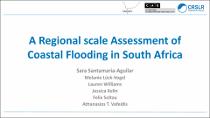JavaScript is disabled for your browser. Some features of this site may not work without it.
- ResearchSpace
- →
- Research Publications/Outputs
- →
- Conference Publications
- →
- View Item
| dc.contributor.author |
Santamaria-Aguilar, S

|
|
| dc.contributor.author |
Lück-Vogel, Melanie

|
|
| dc.contributor.author |
Williams, L

|
|
| dc.contributor.author |
Kelln, J

|
|
| dc.contributor.author |
Soltau, F

|
|
| dc.contributor.author |
Vafeidis, AT

|
|
| dc.date.accessioned | 2021-03-10T11:05:42Z | |
| dc.date.available | 2021-03-10T11:05:42Z | |
| dc.date.issued | 2020-10 | |
| dc.identifier.citation | Santamaria-Aguilar, S., Lück-Vogel, M., Williams, L., Kelln, J., Soltau, F. & Vafeidis, A. 2020. A regional scale assessment of coastal flooding in South Africa. http://hdl.handle.net/10204/11885 . | en_ZA |
| dc.identifier.uri | http://hdl.handle.net/10204/11885 | |
| dc.description.abstract | The coast of South Africa is subject to flooding from a combination of waves, storm surges and tides. Present flood risk can be exacerbated due to climate change, which can induce changes in the Agulhas current system. This would have a direct influence on the regional sea-level and atmospheric conditions and could affect flooding along the coast. The CASISAC* project aims to assess these changes and their implications on coastal flooding in South Africa by a modelling chain that combines models of ocean, atmospheric and coastal processes. We focus on the coastal flood modelling part using the storm surges and tides generated from the modelling chain, and waves from CSIRO1, as hazard scenarios. Flooding is simulated at regional scale for the entire South African coast using the simplified hydrodynamic model LISFLOOD-FP2, which simulates the dynamic propagation of the flood wave, also accounting for surface roughness. Due to model limitations, we divide the coast of South Africa in 27 subdomains of varying size, depending on the coastline orientation, for which flooding is simulated independently. We explore different parametric approaches for incorporating the wave contribution to the still water hydrograph as LISFLOOD_FP does not account for wave propagation processes. Last, we compare our results to those of the national coastal climate change vulnerability assessment conducted by the CSIR for DEA, in which a modified bathtub model was used. Through this comparison we assess the uncertainties introduced in regional flood assessments due to the modelling approach and selection of hazard scenarios. | en_US |
| dc.format | Fulltext | en_US |
| dc.language.iso | en | en_US |
| dc.source | Coastal Hazards in Africa Conference, (virtual conference) Durban, South Africa, 27-29 Oct 2020 | en_US |
| dc.subject | Coastal flooding | en_US |
| dc.subject | Hydrodynamic modelling | en_US |
| dc.subject | LISFLOOD-FP | en_US |
| dc.title | A regional scale assessment of coastal flooding in South Africa | en_US |
| dc.type | Conference Presentation | en_US |
| dc.description.pages | 12pp | en_US |
| dc.description.note | Presentation delivered at the Coastal Hazards in Africa Conference, (virtual conference) Durban, South Africa, 27-29 Oct 2020 | en_US |
| dc.description.cluster | Smart Places | |
| dc.description.impactarea | Coastal Systems | |
| dc.identifier.apacitation | Santamaria-Aguilar, S., Lück-Vogel, M., Williams, L., Kelln, J., Soltau, F., & Vafeidis, A. (2020). A regional scale assessment of coastal flooding in South Africa. http://hdl.handle.net/10204/11885 | en_ZA |
| dc.identifier.chicagocitation | Santamaria-Aguilar, S, Melanie Lück-Vogel, L Williams, J Kelln, F Soltau, and AT Vafeidis. "A regional scale assessment of coastal flooding in South Africa." <i>Coastal Hazards in Africa Conference, (virtual conference) Durban, South Africa, 27-29 Oct 2020</i> (2020): http://hdl.handle.net/10204/11885 | en_ZA |
| dc.identifier.vancouvercitation | Santamaria-Aguilar S, Lück-Vogel M, Williams L, Kelln J, Soltau F, Vafeidis A, A regional scale assessment of coastal flooding in South Africa; 2020. http://hdl.handle.net/10204/11885 . | en_ZA |
| dc.identifier.ris | TY - Conference Presentation AU - Santamaria-Aguilar, S AU - Lück-Vogel, Melanie AU - Williams, L AU - Kelln, J AU - Soltau, F AU - Vafeidis, AT AB - The coast of South Africa is subject to flooding from a combination of waves, storm surges and tides. Present flood risk can be exacerbated due to climate change, which can induce changes in the Agulhas current system. This would have a direct influence on the regional sea-level and atmospheric conditions and could affect flooding along the coast. The CASISAC* project aims to assess these changes and their implications on coastal flooding in South Africa by a modelling chain that combines models of ocean, atmospheric and coastal processes. We focus on the coastal flood modelling part using the storm surges and tides generated from the modelling chain, and waves from CSIRO1, as hazard scenarios. Flooding is simulated at regional scale for the entire South African coast using the simplified hydrodynamic model LISFLOOD-FP2, which simulates the dynamic propagation of the flood wave, also accounting for surface roughness. Due to model limitations, we divide the coast of South Africa in 27 subdomains of varying size, depending on the coastline orientation, for which flooding is simulated independently. We explore different parametric approaches for incorporating the wave contribution to the still water hydrograph as LISFLOOD_FP does not account for wave propagation processes. Last, we compare our results to those of the national coastal climate change vulnerability assessment conducted by the CSIR for DEA, in which a modified bathtub model was used. Through this comparison we assess the uncertainties introduced in regional flood assessments due to the modelling approach and selection of hazard scenarios. DA - 2020-10 DB - ResearchSpace DP - CSIR J1 - Coastal Hazards in Africa Conference, (virtual conference) Durban, South Africa, 27-29 Oct 2020 KW - Coastal flooding KW - Hydrodynamic modelling KW - LISFLOOD-FP LK - https://researchspace.csir.co.za PY - 2020 T1 - A regional scale assessment of coastal flooding in South Africa TI - A regional scale assessment of coastal flooding in South Africa UR - http://hdl.handle.net/10204/11885 ER - | en_ZA |
| dc.identifier.worklist | 24356 | en_US |






